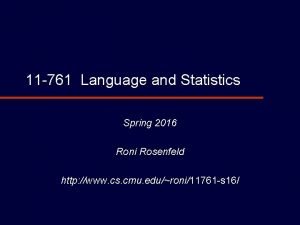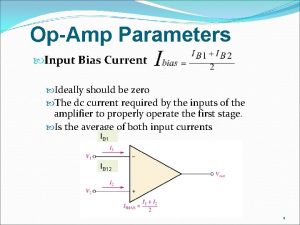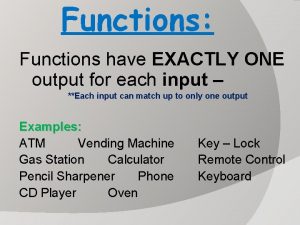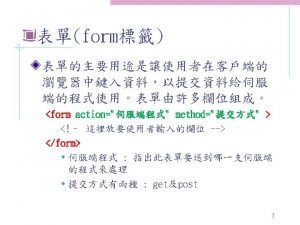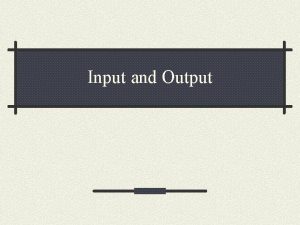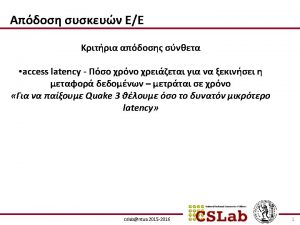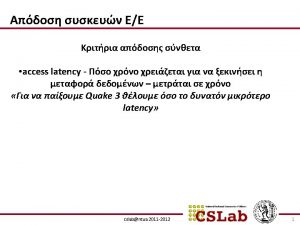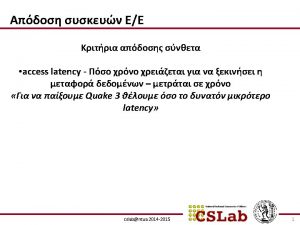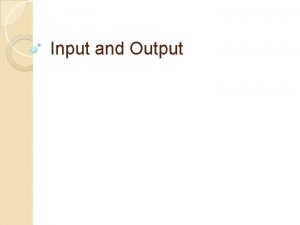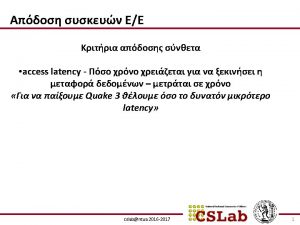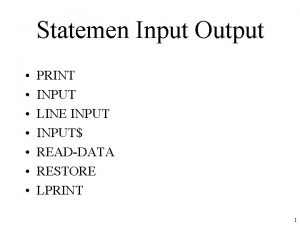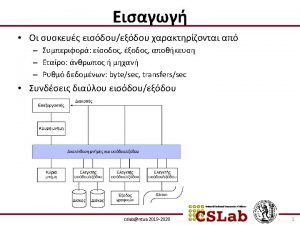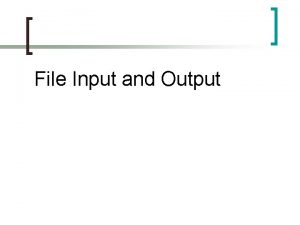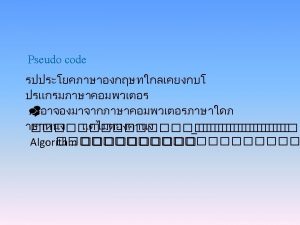761 l current input for each layer in










































![실행결과 43/61 [[0. 02391914] [0. 9757925 ] [0. 97343127] [0. 03041428]] 실행결과 43/61 [[0. 02391914] [0. 9757925 ] [0. 97343127] [0. 03041428]]](https://slidetodoc.com/presentation_image_h/ac87a03f6d3c10f3fed99443628da030/image-43.jpg)






![학습 과정 정의 50/61 model. compile(loss='mse', optimizer='sgd', metrics=['accuracy']) model. fit(X, y, epochs=5, batch_size=32) 학습 학습 과정 정의 50/61 model. compile(loss='mse', optimizer='sgd', metrics=['accuracy']) model. fit(X, y, epochs=5, batch_size=32) 학습](https://slidetodoc.com/presentation_image_h/ac87a03f6d3c10f3fed99443628da030/image-50.jpg)



![Keras 예제 #2 실행결과 54/61 [[0. 19608304] [0. 64313614] [0. 6822454 ] [0. 53627 Keras 예제 #2 실행결과 54/61 [[0. 19608304] [0. 64313614] [0. 6822454 ] [0. 53627](https://slidetodoc.com/presentation_image_h/ac87a03f6d3c10f3fed99443628da030/image-54.jpg)







- Slides: 61







역전파 학습 알고리즘 7/61 l 순방향 출력 계산 current = input for each layer in network for each neuron i in layer net = get_sum(weights[i], current) # 입력의 가중합을 계산 output[i] = activation_func(net) # 각 노드들의 출력을 계산한다. current = output # 다음 계층은 현재 계층의 출력을 입력으로 사용한다.




경사 하강법 프로그래밍 11/61 x = 10 learning_rate = 0. 01 precision = 0. 00001 max_iterations = 100 # 손실 함수를 람다식으로 정의한다. loss_func = lambda x: (x-3)**2 + 10 # 그래디언트를 람다식으로 정의한다. 손실 함수의 1차 미분값이다. gradient = lambda x: 2*x-6 # 그래디언트 강하법 for i in range(max_iterations): x = x - learning_rate * gradient(x) print("손실 함수값(", x, ")=", loss_func(x)) print("최소값 = ", x)

실행 결과 12/61. . . 손실 함수값( 4. 02701132062644 )= 11. 054752252694865 손실 함수값( 4. 006471094213911 )= 11. 012984063488148 손실 함수값( 3. 9863416723296328 )= 10. 972869894574016 손실 함수값( 3. 9666148388830402 )= 10. 934344246748886 손실 함수값( 3. 947282542105379 )= 10. 897344214577629 손실 함수값( 3. 9283368912632715 )= 10. 861809383680356 최소값 = 3. 9283368912632715










Lab: 역전파 알고리즘 시뮬레이 션 22/61 l http: //www. emergentmind. com/neural-network




















![실행결과 4361 0 02391914 0 9757925 0 97343127 0 03041428 실행결과 43/61 [[0. 02391914] [0. 9757925 ] [0. 97343127] [0. 03041428]]](https://slidetodoc.com/presentation_image_h/ac87a03f6d3c10f3fed99443628da030/image-43.jpg)
실행결과 43/61 [[0. 02391914] [0. 9757925 ] [0. 97343127] [0. 03041428]]






모델 작성 49/61 from tf. keras. models import Sequential model = Sequential() from tf. keras. layers import Dense model. add(Dense(units=64, activation='sigmoid', input_dim=100)) # ① model. add(Dense(units=10, activation='sigmoid')) #②
![학습 과정 정의 5061 model compilelossmse optimizersgd metricsaccuracy model fitX y epochs5 batchsize32 학습 학습 과정 정의 50/61 model. compile(loss='mse', optimizer='sgd', metrics=['accuracy']) model. fit(X, y, epochs=5, batch_size=32) 학습](https://slidetodoc.com/presentation_image_h/ac87a03f6d3c10f3fed99443628da030/image-50.jpg)
학습 과정 정의 50/61 model. compile(loss='mse', optimizer='sgd', metrics=['accuracy']) model. fit(X, y, epochs=5, batch_size=32) 학습 loss_and_metrics = model. evaluate(X, y, batch_size=128) classes = model. predict(new_X, batch_size=128) 평가와 예측

Keras 예제 #1 선형 회귀 51/61 import tensorflow as tf import numpy as np import matplotlib. pyplot as plt # 가상적인 데이터 생성 X = data = np. linspace(1, 2, 200) # 시작값=1, 종료값=2, 개수=200 y = x*4 + np. random. randn(200) * 0. 3 # x를 4배로 하고 편차 0. 3정도의 가우시안 잡음 추가 model = tf. keras. models. Sequential() model. add(tf. keras. layers. Dense(1, input_dim=1, activation='linear')) model. compile(optimizer='sgd', loss='mse', metrics=['mse']) model. fit(X, y, batch_size=1, epochs=30) predict = model. predict(data) plt. plot(data, predict, 'b', data, y, 'k. ') # 첫 번째 그래프는 파란색 마커로 plt. show() # 두 번째 그래프는 검정색. 으로 그린다.


Keras 예제 #2 XOR 53/61 import tensorflow as tf import numpy as np X = np. array([[0, 0], [0, 1], [1, 0], [1, 1]]) y = np. array([[0], [1], [0]]) model = tf. keras. models. Sequential() model. add(tf. keras. layers. Dense(2, input_dim=2, activation='sigmoid')) model. add(tf. keras. layers. Dense(1, activation='sigmoid')) sgd = tf. keras. optimizers. SGD(lr=0. 1) model. compile(loss='mean_squared_error', optimizer=sgd) model. fit(X, y, batch_size=1, epochs=1000) print(model. predict(X))
![Keras 예제 2 실행결과 5461 0 19608304 0 64313614 0 6822454 0 53627 Keras 예제 #2 실행결과 54/61 [[0. 19608304] [0. 64313614] [0. 6822454 ] [0. 53627](https://slidetodoc.com/presentation_image_h/ac87a03f6d3c10f3fed99443628da030/image-54.jpg)
Keras 예제 #2 실행결과 54/61 [[0. 19608304] [0. 64313614] [0. 6822454 ] [0. 53627 ]] [[0. 02743807] [0. 9702845 ] [0. 9704155 ] [0. 03712982]] 반복횟수(에포크) 를 10000으로 늘 린다면

Lab: MLP를 사용한 MNIST 숫자 인식 55/61

Lab: MLP를 사용한 MNIST 숫자 인식 56/61 import tensorflow as tf batch_size = 128 # 가중치를 변경하기 전에 처리하는 샘플의 개수 num_classes = 10 # 출력 클래스의 개수 epochs = 20 # 에포크의 개수 # 데이터를 학습 데이터와 테스트 데이터로 나눈다. (x_train, y_train), (x_test, y_test) = tf. keras. datasets. mnist. load_data() # 입력 이미지를 2차원에서 1차원 벡터로 변경한다. x_train = x_train. reshape(60000, 784) x_test = x_test. reshape(10000, 784) # 입력 이미지의 픽셀 값이 0. 0에서 1. 0 사이의 값이 되게 한다. x_train = x_train. astype('float 32') x_test = x_test. astype('float 32') x_train /= 255 x_test /= 255

Lab: MLP를 사용한 MNIST 숫자 인식 57/61 # 클래스의 개수에 따라서 하나의 출력 픽셀만이 1이 되게 한다. # 예를 들면 1 0 0 0 0 0과 같다. y_train = tf. keras. utils. to_categorical(y_train, num_classes) y_test = tf. keras. utils. to_categorical(y_test, num_classes) # 신경망의 모델을 구축한다. model = tf. keras. models. Sequential() model. add(tf. keras. layers. Dense(512, activation='sigmoid', input_shape=(784, ))) model. add(tf. keras. layers. Dense(num_classes, activation='sigmoid')) model. summary() sgd = tf. keras. optimizers. SGD(lr=0. 1)

Lab: MLP를 사용한 MNIST 숫자 인식 58/61 # 손실 함수를 제곱 오차 함수로 설정하고 학습 알고리즘은 SGD 방식으로 한다. model. compile(loss='mean_squared_error', optimizer=sgd, metrics=['accuracy']) # 학습을 수행한다. history = model. fit(x_train, y_train, batch_size=batch_size, epochs=epochs) # 학습을 평가한다. score = model. evaluate(x_test, y_test, verbose=0) print('테스트 손실값: ', score[0]) print('테스트 정확도: ', score[1])

실행결과 59/61 _________________________________ Layer (type) Output Shape Param # ================================= dense_4 (Dense) (None, 512) 401920 _________________________________ dense_5 (Dense) (None, 10) 5130 ================================= Total params: 407, 050 Trainable params: 407, 050 Non-trainable params: 0. . . Epoch 18/20 60000/60000 [===============] - 1 s 18 us/sample - loss: 0. 0344 acc: 0. 8480 Epoch 19/20 60000/60000 [===============] - 1 s 18 us/sample - loss: 0. 0335 acc: 0. 8505 Epoch 20/20 60000/60000 [===============] - 1 s 18 us/sample - loss: 0. 0328 acc: 0. 8530 테스트 손실값: 0. 03148304631710053 테스트 정확도: 0. 8628


Q&A 61/61
 761
761 Cg-761
Cg-761 Emagramme 761
Emagramme 761 Pigmented layer and neural layer
Pigmented layer and neural layer Parietal layer and visceral layer
Parietal layer and visceral layer Secure socket layer and transport layer security
Secure socket layer and transport layer security Presentation layer functions
Presentation layer functions Secure socket layer and transport layer security
Secure socket layer and transport layer security Secure socket layer and transport layer security
Secure socket layer and transport layer security Secure socket layer and transport layer security
Secure socket layer and transport layer security Layer 2 e layer 3
Layer 2 e layer 3 Layer-by-layer assembly
Layer-by-layer assembly Layer 2 vs layer 3 bitstream
Layer 2 vs layer 3 bitstream Y connected generator
Y connected generator Difference between phase voltage and line voltage
Difference between phase voltage and line voltage Energy band diagram of pnp transistor
Energy band diagram of pnp transistor Ac systems lesson 4
Ac systems lesson 4 Drift vs diffusion current
Drift vs diffusion current What is diffusion current and drift current
What is diffusion current and drift current Pinch off voltage
Pinch off voltage Balanced delta delta connection
Balanced delta delta connection Holding current and latching current
Holding current and latching current Diffusion current formula
Diffusion current formula Why is sma welding current referred to as constant current?
Why is sma welding current referred to as constant current? Touch current vs leakage current
Touch current vs leakage current Non planar circuit
Non planar circuit Tlu perceptron
Tlu perceptron Eugene wong berkeley
Eugene wong berkeley Input layer
Input layer Ideally the input bias current should be__________ . *
Ideally the input bias current should be__________ . * Peripheral output adalah.
Peripheral output adalah. Finely tuned input and roughly tuned input
Finely tuned input and roughly tuned input Each input has one output
Each input has one output Formuö
Formuö Novell typiska drag
Novell typiska drag Nationell inriktning för artificiell intelligens
Nationell inriktning för artificiell intelligens Ekologiskt fotavtryck
Ekologiskt fotavtryck Shingelfrisyren
Shingelfrisyren En lathund för arbete med kontinuitetshantering
En lathund för arbete med kontinuitetshantering Kassaregister ideell förening
Kassaregister ideell förening Vilotidsbok
Vilotidsbok Anatomi organ reproduksi
Anatomi organ reproduksi Förklara densitet för barn
Förklara densitet för barn Datorkunskap för nybörjare
Datorkunskap för nybörjare Boverket ka
Boverket ka Att skriva en debattartikel
Att skriva en debattartikel Delegerande ledarskap
Delegerande ledarskap Nyckelkompetenser för livslångt lärande
Nyckelkompetenser för livslångt lärande Påbyggnader för flakfordon
Påbyggnader för flakfordon Arkimedes princip formel
Arkimedes princip formel Offentlig förvaltning
Offentlig förvaltning Kyssande vind
Kyssande vind Presentera för publik crossboss
Presentera för publik crossboss Jiddisch
Jiddisch Bat mitza
Bat mitza Klassificeringsstruktur för kommunala verksamheter
Klassificeringsstruktur för kommunala verksamheter Fimbrietratt
Fimbrietratt Bästa kameran för astrofoto
Bästa kameran för astrofoto Cks
Cks Lågenergihus nyproduktion
Lågenergihus nyproduktion Mat för idrottare
Mat för idrottare Verktyg för automatisering av utbetalningar
Verktyg för automatisering av utbetalningar
